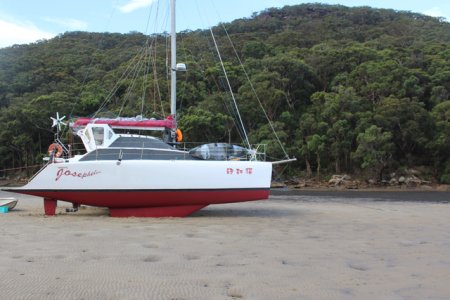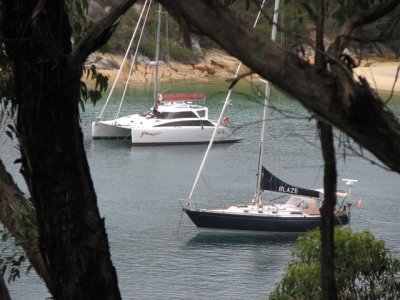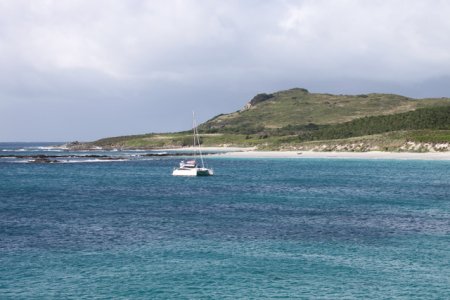GHA
Well-known member
Who says so?but there are some here who state categorically that everybody should have a bigger anchor,
Can't recall anyone saying blanket everybody go bigger.
Do you have any links?
Silly thing to say if so.
Who says so?but there are some here who state categorically that everybody should have a bigger anchor,
You don't seem to have read all of the thread. Post 91 is an example - last sentence. There are others. When challenged no real justification is offered in support. This fellow is often cited youtube.com/watch?v=kMbYfoGFBLQ about 4 minutes in for a stream of misinformation (which shows how out of touch he is). Despite his rant against anchors provided by builders his 30kg Bruce is exactly the size of anchor of that type recommended for his size of boat. Both my new boats were supplied with the correct size anchor, chain and windlass even if the type supplied, particularly the first one) was not the best for the conditions where I anchored most..Who says so?
Can't recall anyone saying blanket everybody go bigger.
Do you have any links?
Silly thing to say if so.

This is why I think it is sensible for the OP, or any cruising boat that plans on anchoring frequently to choose the largest anchor in the best design that they can comfortably manage.
Who says so?
Can't recall anyone saying blanket everybody go bigger.
Do you have any links?
Silly thing to say if so.
Who says so?
Can't recall anyone saying blanket everybody go bigger.
Do you have any links?
Silly thing to say if so.
Pleased we are in agreement, although Still not sure where you get a recommendation of a 20kg Rocna for your boat.A few may say get the biggest anchor you can handle, it's just a beloved aphorism, however the truth police are onto it.
Every case is different, for me as mentioned, I am recommended between 10 and 20 kg which is a world of choice. The size of the thing is generally limited by practical constraints anyways: fitting it to the stem, getting it inboard, shifting it at short notice in poor conditions or at night.
If the boat was fully loaded for bluewater and I had an electric winch, I might go for 15 or even (probably not) 20. But, as I am unlikely to be out in 30kts let alone 50 and I am fairly lightship, I am happy to settle for 10kg and save my back, I won't kid myself that it is a good as an anchor at the top end of the suggested weights.
.
I am not sure if "anchoring frequently" applied to your cruising, but your posts on YBW have highlighted the difficulties of managing with smaller anchors. Practices such as frequently changing your anchor design to best suit the substrate, not trusting a scope of less than 5:1 overnight, and deploying multiple anchors in winds of more than 25 knots are all posts you have made on previous anchor threads. These hassles should not be necessary.On our 38' cat we used a 8kg aluminium anchor, same physical size as the 15kg steel equivalent. We could comfortably have used a 25kg or 30kg anchor on the Maxwell windlass (the windlass was designed for the size of yacht). If the windlass had failed the 25/30kg anchor could have been lifted by hand (though the 6mm chain would have been a benefit) both Noelex and Zing suggest, 25kg would have been 'their' choice.
Jonathan
3 months every summer at anchor seems to be fairly frequent anchoring. Most anchorage we used were large and empty - why would you anchor with a 3:1 scope when you can anchor at 5:1. Why carry, in our case, 75m of rode and not use it - its of no value sitting in a locker.I am not sure if "anchoring frequently" applied to your cruising, but your posts on YBW have highlighted the difficulties of managing with smaller anchors. Practices such as frequently changing your anchor design to best suit the substrate, not trusting a scope of less than 5:1 overnight, and deploying multiple anchors in winds of more than 25 knots are all posts you have made on previous anchor threads. These hassles should not be necessary.
To be fair, your preferred primary aluminium Spade anchor was at least one size below the manufacturer’s recomended size for your catamaran so these issues do not reflect what someone following the manufacturer’s recommendations would experience.
If you can comfortably manage an anchor 10kg heavier what do you have to lose? It would likely be cheaper than carrying the many primary anchors required when frequently switching anchors or to have the multiple back ups needed should you need to cut your anchors free when two anchors are deployed.
It would certainly be far less hassle. Try the KISS approach on your next yacht.
Carrying a second primary anchor as a spare is sensible and most cruising boat do this, but if you regularly need to deploy two primary anchors you need to carry four if you want a spare should you need to cut away your anchors in strong wind.No spare anchor in case you lose the single primary, no second anchor if the anchorage suffers a veering wind. Seems pretty unprofessional to me - but each to their own.
You really don't understand, or more likely are just being obtuse.Carrying a second primary anchor as a spare is sensible and most cruising boat do this, but if you regularly need to deploy two primary anchors you need to carry four if you want a spare should you need to cut away your anchors in strong wind.
In addition, if you regularly want to deploy two anchors you need two rodes (plus back ups). This will consist of at least partial chain and if cruising areas with abrasive substrates, long lengths of chain will be needed. Even if using lightweight 6mm chain, carrying merely an extra 12m of chain will weigh more than the 10kg that you have "saved" by fitting a small undersized anchor.
More concerning is the `added hassle of your complicated system necessary when choosing small anchors. Anytime the wind picks up unexpectedly I would be concerned that perhaps I should have deployed two anchors. Adding a second anchor in the middle of the night (why does strong wind always arrive at 2am?) is not my idea of fun and is not necessary if you choose ground tackle sensibly.





The answer to that is simple. It is totally unnecessary.If you can comfortably manage an anchor 10kg heavier what do you have to lose? It would likely be cheaper than carrying the many primary anchors required when frequently switching anchors or to have the multiple back ups needed should you need to cut your anchors free when two anchors are deployed.
Pleased we are in agreement, although Still not sure where you get a recommendation of a 20kg Rocna for your boat.
Well, if it were me (which it is isn't) - I'd choose an aluminium 8kg Spade or Excel. We used either, only one or the other, for everyday anchoring for 20 years on a 38' x 7t cat.The boat in question is 10 metres in round figures. It displaces over 5 tons. The suggested anchor size from Rocna is 15 - 20kg for a boat between 5 and 9 tons. Your choice depends both on the boat and your proposed use, as Green says:
"Consider the worst-case scenario for your anticipated Anchoring - this will dictate whether you go for the minimum required or the ocean cruising approach"
Of course if you don't believe that performance increases with size, you are free to choose the smallest you think you can get away with.
.
I always use a length of stretchy nylon warp as a snubber.In all the years I've sailed ... I've never had call to use a 'snubber' other than a short rope to avoid chain grating on the stemhead.
Agreed I do not live aboard or cruise Carib' etc ... just an ordinary boater ...
If the largest anchor size you can comfortably manage is 10kg then we are both in agreement that this is the best choice for your boatEven the next size up (15kg) is difficult to justify as the criteria for the size of boat 2m longer and twice the displacement.
There is more than enough information available to determine the appropriate size of anchor for a particular boat and when to consider moving up a size without resorting to simplistic assertions such as yours.